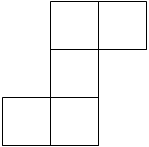Net of an open box II
| Y7 (03/2010) | |
|
No |
very easy |
No  |
easy |
Yes  |
difficult |
Yes  |
moderate |
No  |
easy |
Yes  |
difficult |
Yes  |
moderate |
NOTE:
All 7 shapes correct (including 4 correct nets) – very difficult;
6 shapes correct (including 3 correct nets) – difficult;
5 shapes correct (including 2 correct nets) – moderate.

67% of students did not show that
 could be folded into an open top cube.
could be folded into an open top cube.43% of students did not show that
 could be folded into an open top cube.
could be folded into an open top cube.51% of students did not show that
 could be folded into an open top cube.
could be folded into an open top cube.43% of students did not show that
 could be folded into an open top cube.
could be folded into an open top cube.The above errors relate to students' ability to translate a 2-dimensional net into a three dimensional shape.
 and
and  had the base off centre of a long shape which made it more difficult and could require some visual turning before identifying the folds.
had the base off centre of a long shape which made it more difficult and could require some visual turning before identifying the folds. and
and  were more "centrally structured" about the base and were notably easier.
were more "centrally structured" about the base and were notably easier.Students who could not identify one correct net may need some time exploring the making and folding of nets to develop and understand how they work. The nets in this resource can be enlarged and cut out for students to explore how they fold. Then they can start to visualise nets that fold to shapes.
Correctly identified one net
A small number of students only identified one net. This may relate to a reading error and have been because they were only looking for one. For these students ask them if there are any more shapes that can be folded into an open cube. The nets in this resource can be enlarged and cut out for students to explore how they fold – remind them that the top is open (it is not a total cube).
Correctly identified some of the nets
For students who identified some (but not all the shapes), working in small groups, ask them how many shapes they (as a group) think there are that can fold into the shape. Get them to justify how each can or cannot fold. If appropriate, let them know there are four shapes that can fold. Get students to design several similar nets and have them ask the group to identify whether they can or cannot fold into the shape (or another shape).
Correctly identified all the nets
For students who identified all the nets correctly have them share their findings in a small group and discuss how they can check whether the net folds. Have students describe how the net is folded and then discuss an easy way to identify how they fold (be able to explain to a peer). Showing an X on the base can provide a reference point that illustrates how the net folds not just whether it folds into the shape. Have students design their own nets for other prisms and have them ask others to identify whether the nets can or cannot fold into the prisms, or what shape they fold into.


